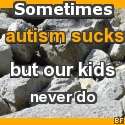

There is a theory in autism treatment that along with a sensory diet, kids with autism may benefit from eliminating gluten and dairy proteins (called casein and whey) from their diets. Gluten is found in grains and nearly all mass-marketed breads, cereals and baked goods. Casein is found in all milk products. Many kids with autism do not process dairy or gluten correctly, and over time, it can hurt their gut. Some refer to this as "silent celiac's disease." The scientific veracity of the diet won't be debated here. My son has been on the diet for over five years and we have seen improvement. Many families have seen success with the diet, but as with all things, your mileage may vary. If you think it might work for you or your child, here are some helpful hints to make the transition to a GFCF diet as painless as possible for all concerned.
* Don't throw away all the food in the house and buy GFCF…yet. Use what you have, but when you buy again, buy GFCF. You can check sites like TACA for acceptable foods and Hidden Ingredients for unacceptable ingredients. Familiarize yourself with the names of ingredients. Print out the list and keep it with you when you shop. Gluten and casein are in many foods you would never expect. Be a label reader!
* Keep a list of what you have tried so if you don't like it, you don't accidentally buy it again. There are some great products out there and some not so great. (you can email me if you would like...I would be happy to provide you with a list of foods from experience).
* Don't change brands of foods that are already "approved" foods. For instance, if the child likes waffles, buy GFCF, but don't change the brand of bacon you serve. Or keep the eggs the same style. Consistency is key. If you change bread, try toasting it and using the same peanut butter, if it is acceptable. Don't change the jelly.
* Find substitutes for tried and true foods. Finding gluten free foods is a lot easier than it used to be. Almost everything can be subbed out. The exception to this, sadly, is cheese. Many of the cheeses that say they are dairy free still have casein. Read your labels!
* When possible, involve the child in food choices. Teach him to read the labels and to understand what happens when he eats foods that his body doesn't tolerate well. Let him pick out some foods he would like to try, and involve him in their preparation. Kids are more willing to eat food they have helped prepare.
* Don't give in. Once you make a decision to try the diet, stick with it. It can take over six months for all traces of casein and gluten to leave the body. Give it a proper trial. The child might protest a bit, but keep at it.
* Make sure to provide a vitamin supplement so that the child is getting proper nutrition. Of course, the best vitamins are from the source food, but if the child won't eat it, vitamins are better than nothing. This is a good suggestion for all kids.
* Consider probiotics, which add good bacteria to the intestinal flora to balance the digestive system. But watch out that they don't contain hidden dairy!
* Limit processed sugars, and cut out artificial colors, flavors, HFCS (high fructose corn syrup) and preservatives from the child's diet when at all possible. These ingredients can cause problems for sensitive kids.
Some local sources of gluten free products follow, but be sure to check the ingredients list because gluten free is not necessarily casein free as well.
Whole Foods- Tustin (there is even a Special Diets page where you can download product lists)
Sprouts - list of locations in Orange County with map
Henry's - list of locations in Orange County with map
Trader Joe's - list of locations with map
Mother's Markets - list of locations in Orange County with map
Don't be too hard on yourself if it isn't perfect... you are learning and so is the child. The goal here is to transition to the diet, not be a Nutritional Hardnose. If you are stressed, the child will figure it out, and he will become stressed as well. With a bit of practice, you will be an excellent label reader and have a collection of foods that work for your child and maybe for you, as well.

































2 sent chocolate:
Sigh. The one of my 3 who I feel might benefit from GFCF is the 'orrible picky eater. He happily helps me prepare and cook food for the rest of the family - he just won't put the stuff in his mouth!
He doesn't do meat, vegetables, fruit, nuts... except in bolognaise sauce (meat *and* fruit).
I'll have to keep working on it :)
Lisa: try disguising his veggies. What will he eat?
Post a Comment